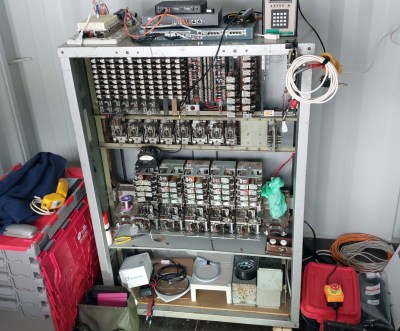A large hacker camp such as EMF 2024 always brings unexpected delights, and one of those could be found in the Null Sector cyberpunk zone: a fully functional Strowger mechanical telephone exchange. Better still, this wasn’t the huge array of racks we’ve come to expect from a mechanical exchange, but a single human-sized unit, maybe on a similar scale to a large refrigerator. [LBPK]’s PAX, or Private Automatic Exchange, is a private telephone network, 1950s style.
 It stood at the back of the container, with a row of four telephones in front of it. We particularly liked the angular “Trimphone”, the height of 1960s and 70s chic. You could dial the other phones in the network with a two digit number, and watch the exchange clicking in the background as you did so. Some of the sounds weren’t quite the same as the full-sized equivalents, with the various tones being replaced by vibrating reeds.
It stood at the back of the container, with a row of four telephones in front of it. We particularly liked the angular “Trimphone”, the height of 1960s and 70s chic. You could dial the other phones in the network with a two digit number, and watch the exchange clicking in the background as you did so. Some of the sounds weren’t quite the same as the full-sized equivalents, with the various tones being replaced by vibrating reeds.
This exchange has an interesting history, being built in 1956 by “Automatic Telephone & Electric” for the Midlands Electricity Board, power generator for much of central England, where it served its commercial life. On decommissioning it went to the Ffestiniog narrow gauge railway, in Wales. He was lucky enough to learn of its existence when the Ffestiniog had no further use for it, and snapped it up.
We have to admit, we want one of these, however he makes clear that it’s an unwieldy machine that requires quite some attention so a Hackaday mechanical exchange will have to remain a dream for now.
















